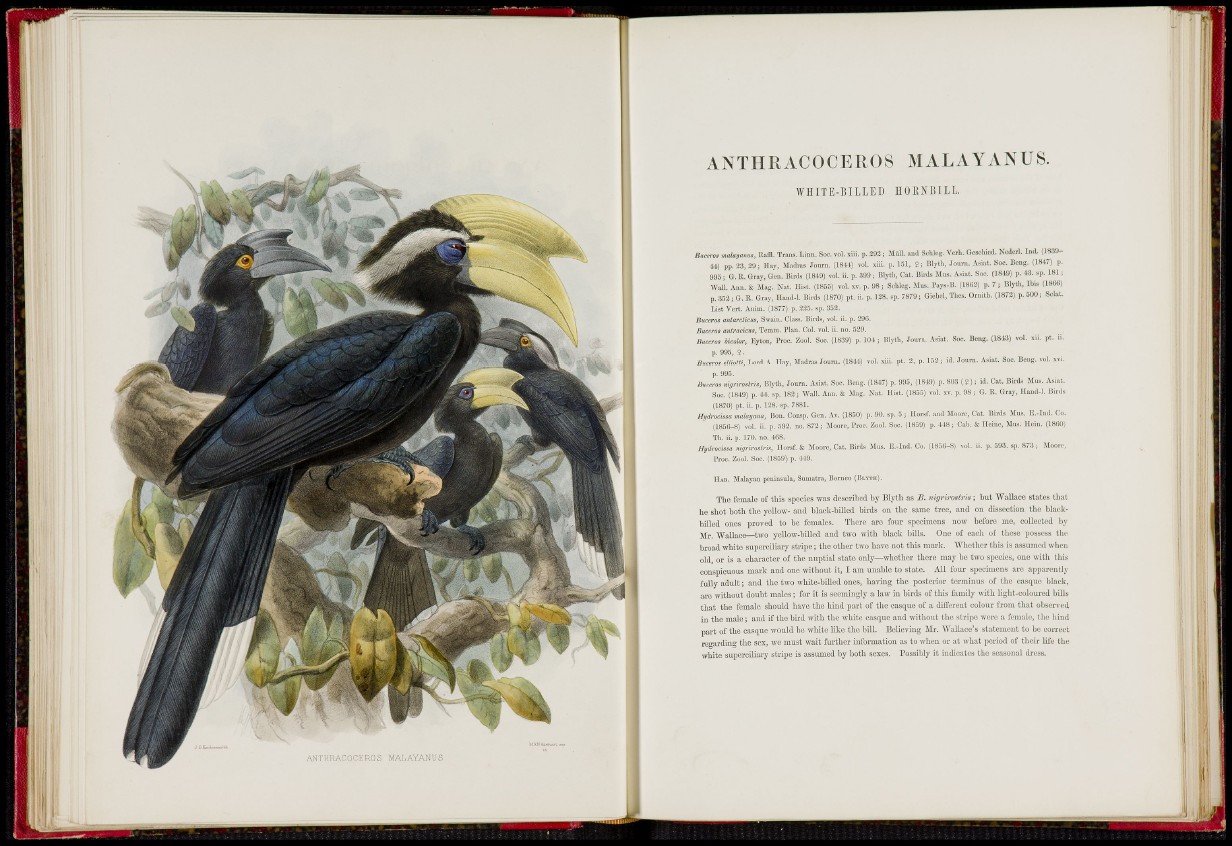
m
ANTHRACOCEROS MALAYANUS.
W H I T E - B I L L E D MOENBILL,
Buceros malayanus, Raffi. Trans. Lina. Soc. vol. xiii. p. 292 ; JÌull, and Schleg. Verb. Gescliied. Ncdcrl. Ind. (IS'Ò'J-
44) pp. 23, 29j Hay, Madras Jonni, (18-11.) vol, xiii. p. 151, 2; Blyth, Jonrn. Asiat. Soc. Bcng. (1847) p.
995 - G. E. Gray, Gen. Birds (1819) vol. ii. p. 399 ; Blyth, Cat. Birds Mus. Asiat. Soc. (1849) p. 43. sp. 181 ;
Wall. Ami. & Mag. Nat. Hist. (1855) vol. xv, p. 98 ; Schleg. Mus. Pays-B. (1862) p. 7 ; Blyth, Ihis (1866)
p. 352 i G. R. Gray, Ilaiid-l. Birds (1870) pt. ii. p. 128. sp. 7879 ; Giehel, Thes. Omi th. (1872) p. 500 ; Sc^at.
List V e r t Anim. (1877) p. 225. sp. 352.
Buceros antarclicus, Swain. Class. Birds, vol. ii, p. 296.
Bucero» aniracicus, Temni, Plan. Col. vol, ii, no. 529.
Buceros bicohr, Kyton, Proe. Zool. Soc. (1839) p. 101 ; Blyth, Journ. Asiat. Soc. Bcng. (18-13} vol. xii. pt, ii.
p. 995, ?.
Buceros elliotti, Lord A. Hay, Madras Journ. (1841) vol. xiii, pt. 2, p. 153 ; id, Joura. Asiat, Soc. Bcng. vol. xvi,
p, 995.
Buceros mgrirostris, Blyth, Joura. Asiat. Soc. Bcng, (1847) p. 995, (1849) p, 803 ( 2 ) ; id. Cat. Birds Mus. Asiat,
Soc, (1849) p. 44. sp. 182; Wall. Ann. & Mag. Nat, Hist. (1855) vol. xv, p. 9 8 ; G. R. Gray, Haud-I, Kirds
(1870) pt. ii. p, 128. sp. 7881.
Hydvocissa malayana, Bon. Consp. Gen. Av. (1850) p. 90, sp, 5 ; Horsf, and Moore, Cat. Birds Mus. li.-Ind. Co.
(1806-8) vol. ii. p. 592. no. 872; Moore, Proc. Zool. Soc. (1859) p- 4 1 8 ; Cab. & Heine, Mus. Hein. (1800)
Th. ii. p, 170. ao, 468.
Hydrocissa nigriroslris, Horsf. & Moore, Cat. Birds Mus. Ji.-Iiid, Co. (1856-8) vol, ii. p, 593. sp. 873 ; Moure,
Proc. Zool. Soc, (1859) p. 4-19.
HAB. Malayaa peuinsala, Sumatra, Borneo (BLYTH).
The female of this species was described by Blylh as B. nigrirostris ; but Wallace states that
he shot both the yellow- and black-billed birds on the same tree, and on dissection the blackbilled
ones proved to bo females. There are four specimens now before me, collected by
Mr. Wallace—two yellow-billed and two with black bills. One of eacli of these possess tlubroad
white superciliary stripe ; the other two have not this mark. Whether this is assumed wlieii
old, or is a character of the nuptial state only—whether there may be two species, one witli this
conspicuous mark and one without it, I am unable to state. All four specimens are apparently
fully adult ; and the two white-billed ones, having the posterior terminus of the cas(jue black,
arc without doubt males ; for it is seemingly a law in birds of this family with ligiit-coloured bills
that the female should liave the hind part of the casque of a different colour from that observc^d
in the male ; and if tlie bird with the white casque and without the stripe were a female, the liind
part of the casque would be white like the bill. Believing Mr. Wallace's statement to be correct
regarding the sex, we must wait further information as to when or at what period of their life the
white superciliary stripe is assumed by both sexes. Possibly it indicates the seasonal dress.